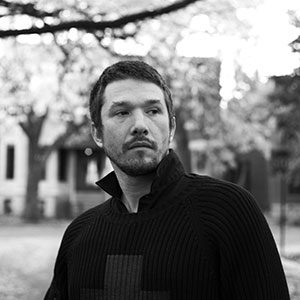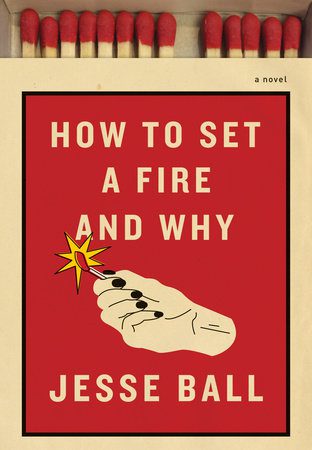
It can be hard to describe a Jesse Ball novel. They’re willfully strange, dark and puzzling, but the pieces aren’t always designed to fit together. Instead, each of his books, which are always written in the first person, have a tendency to take the reader into the heads of the lead characters, which is often more treacherous than the physical landscape. This is certainly true in his newest novel, How To Set a Fire and Why, which I argue is possibly his best yet. The story follows Lucia, whose father is dead and mother is in a mental hospital. She’s incredibly smart but troubled. She lives with her aunt in a converted garage. Lucia creates a code of conduct for herself but when she discovers that her new school has an arson club, she wants to join. The book is unsettling, full of odd ideas and creepy vignettes. It also features a complicated protagonist, a smart, angry outsider dealing with issues of class, her own rage, and discovering a way to live in the world.
How to Set a Fire and Why follows on the heels of Ball’s A Cure for Suicide, which was on the longlist for the 2015 National Book Award, and comes out just before The Deaths of Henry King, a new graphic novel he co-authored with Brian Evenson and Lilli Carre, which is published by Uncivilized Press. We spoke recently by e-mail about humor, design, poverty, and how Ball writes.
***
The Rumpus: This is your sixth novel. Has the process of writing a novel changed over the time you’ve been writing fiction?
Jesse Ball: I’d say writing is easier for me now than it once was, but I do less of it. I am clearer in my mind and a bit less confused than I used to be.
Rumpus: Does that mean you do less rewriting? Is it a change in how you work?
Ball: That’s not what I meant. How it is—is that I’m clearer now in what I want to say, and I know better how to say just that. I want to say less, and it’s easier to say less.
Rumpus: You always seem interested in writing a different book each time. Do you set out with the goal of doing something different, of focusing on a different element each time?
Ball: I have a different purpose in writing each novel. Some of them seem more similar than others, but the purposes are always different. The Way Through Doors is about story itself. Samedi the Deafness is about falsehood. The Curfew about parenthood. Silence Once Begun about confession. Cure for Suicide is about memory and suicide. How to Set a Fire is about poverty. In a way none of those books is about anything at all—that’s true too.
Rumpus: How does that manifest itself? Do you start thinking about poverty, and then what happens? Do you think about that and write with that in mind at the beginning?
Ball: The books turn out to be about things afterwards. I don’t go into them with concepts, for the most part. A beginning idea for a book might be: a boy emerges from a hole in the ground. He enters a house. The book will take place in the first ten minutes following his arrival.
Rumpus: Why do you create a new structure for each novel you write, or is that simply a question of each story needing to be told in its own way?
Ball: Just as you say. Also, the books are written and different times and different structures make more sense at one point in life than at another.
Rumpus: How do you write a novel? Do you sit down with an outline or a plan or is it an act of discovery?
Ball: I have a very basic notion of the structure the book might have—that’s mostly it. The rest is luck and happenstance.
Rumpus: How does that compare to the way that you write poetry?
Ball: The methods are very similar. You want to be moved by something.
Rumpus: How do you describe Lucia? Did your thinking about her change over the course of writing the book?
Ball: I try not to describe her. The book itself is my thinking about her. I know more about her at the end than I did at the beginning.
Rumpus: Do you construct characters by starting to think of an idea, like poverty as we were talking before?
Ball: I don’t start with an idea or concept in the sense that I flesh out an idea or concept and set it at the center of something. What I meant was—I begin with an image of some sort, just as if you saw something out of a window, and then went to the window to see what it was.
Rumpus: There is an ongoing dialogue about likability and relating to characters. Mostly about female characters. Do you think about this at all as a writer or reader?
Ball: No. Lucia seemed perfectly relatable.
Rumpus: Was there a specific challenge in writing a book from the point of view of a teenage girl?
Ball: I found her easy to get along with. Maybe she ended up loving books a little more than she should?
Rumpus: There’s a lot of humor in the book, most of it from Lucia, and I don’t think of you as a necessarily funny writer. Was that something you expected?
Ball: I believe my friends think I’m funny. All the books are full of humor. Maybe it is a quiet sort of humor that masquerades as not-much-at-all. It is certainly easy to miss.
Rumpus: What do you find interesting about writing in the first person?
Ball: Third person is the narrator’s first person—so you are essentially always in a sort of first person. The first-person conceit is an odd one, but pleasant to engage in. The second part of Cure for Suicide is in first person, a sort of Bernhard first person. Much of my work has been done in first person.
Rumpus: I wondered if you could talk a little about how you write about the settings of your books because you draw them in very minimalist ways. Did that mean something different for this book?
Ball: The minimalism is simply in service of the book’s goal, which is to be the place where I am considering an idea at length. Clarity is the most important thing to me—in thinking—and so I try in the books to be as clear as possible. Generally in the books not very much happens. I don’t think anything needs to happen in a book. A book can just be a description of a stick being snapped in half. If the reader is brought to feel the plight of the stick, well, you can imagine what that would be like.
Rumpus: When you were talking about minimalism and the setting, I thought of comics and those panels where it only depicts a character or an action and the background is white because it’s just not important then. I think of your books as having scenes with background here and there, but mostly consist of white panels. Does that seem right?
Ball: That’s a lovely way to think about it. To me, though, it is more that those blank spaces tend to fill of their own accord with things germane to the reader.
Rumpus: Did you get a say over the book’s design?
Ball: I get some say. Did you like how it turned out?
Rumpus: I loved the design, where the book resembles a matchbox, with the raised texture of the matches and the striking paper. How much of that was you?
Ball: Years ago I wanted a book where the cover was a box, a trompe-l’oeil. That didn’t happen then. But I thought a matchbox would be a good concept for this one. The designer did a beautiful job with those raised textures you describe, and also with striking the line between an actual matchbox and the idea of a matchbox. One of the best things about this cover is that it functions beautifully on the internet as the image of the cover. Of course it is lovely when holding the book, but some covers that are lovely to hold are inscrutable when looked at inside a telephone.
Rumpus: Do you typically have ideas or a say over the book design?
Ball: A person always has a chance to protest this or that. Pantheon and Vintage have done a lovely job matching the content of the books with what are generally rather precise covers. My favorite of them all is the cover for The Way Through Doors. What will happen is that they bring me a cover and say—what do you think about this? Then I’ll say, yes, I like that. Another of my favorites is the paperback cover for Cure for Suicide. As far as ideas about book design: I have plenty. But I also try and let people do their jobs. I have designed covers for some Icelandic books, including the complete design inside and out of Vera & Linus. I like small books. I like durable books. I like plain books. I like small type and thin pages.
Rumpus: You’re a fairly prolific writer and you craft these dark and experimental books and as a reader it feels like most of the writers who do that who get published and get attention are dead, or in translation, but it doesn’t feel like there are many contemporary American writers who do this. Or maybe get the chance to do this? Do you have a sense of feeling like an outsider in this sense?
Ball: It is like having a large dead bird strapped to your leg at all times. Those who like such things, and they are few, are overjoyed to see you.
Americans are genuinely and profoundly anti-intellectual. They are especially so in their pleasure-seeking, which is epically banal. If they are to read something that is difficult, they will only do so supposing they will be admired for having done it. Anyway—I don’t read books for pleasure, but in desperation. I’m confused, and brilliant books help me to be less so.





